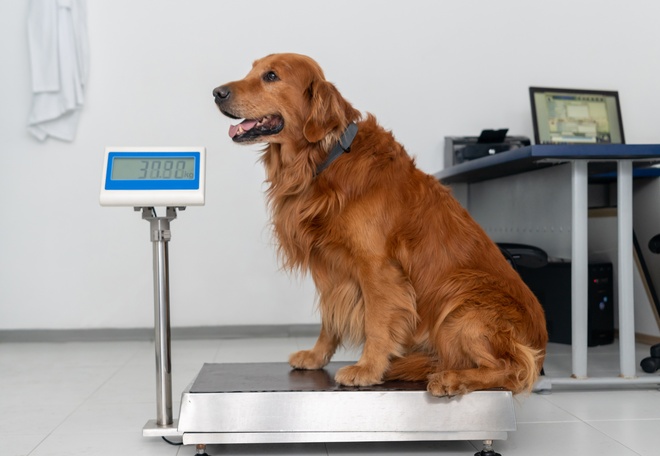Overweight is an issue that also affects our four-legged friends. In France, 30-40% of dogs and cats suffer from being overweight. Here, our animal care expert Sylvia Masson shares tips on how to identify an overweight pet and how to maintain an ideal weight. Because a healthy pet is a happy pet!

Reading time : 2 min
Obesity in animals is often caused by a diet that is too rich compared to their physical activity. It is therefore essential to adjust their food portions according to their activity level.
Certain dog and cat breeds are more prone to weight gain. For example, Sylvia Masson, a veterinary behaviorist, explains that “a study identified the POMC gene, present in Labrador Retrievers and Golden Retrievers, and showed that animals with this particular mutation tend to be obese even when eating a relatively normal portion.” Other breeds, such as Beagles, Australian Shepherds, and Brittany Spaniels, are also prone to obesity. On the other hand, breeds like Greyhounds or Jack Russells (who possess a hypermuscular gene), as well as hyperactive dogs, find it harder to gain weight.
An overweight pet displays obvious physical signs, such as ribs that are no longer visible. To determine if a pet is overweight, simply check if you can feel their ribs by touch. However, our experts recommend consulting a veterinarian to determine your pet’s optimal weight. Sylvia Masson also points out that “it’s mainly changes in activity levels that should raise concern, whether it’s an increase or a decrease.” Signs like abnormal shortness of breath, reluctance to exert effort, or slowness during walks may indicate overweight, but they could also point to other health issues. It’s best to consult a veterinarian.
According to Sylvia Masson, “the primary problem related to overweight is joint issues.” Indeed, excess weight puts additional strain on the joints, increasing the risk of osteoarticular diseases. Overweight is also associated with metabolic complications, such as diabetes, and puts extra pressure on the heart, increasing the risk of heart disease.
In recent years, many companies have proposed innovations to better manage pets’ weight. These include new low-calorie dietary foods, smart bowls that precisely measure food portions, and activity tracking devices. Sylvia Masson also notes that “activity tracking systems, like those offered by Weenect, allow you to monitor your pet’s physical activity and consider tailored programs with specific goals.”
As Sylvia Masson explains, “for overweight, it’s really better to prevent than to cure, so pay attention to rapid weight gain and immediately adjust the portion size.”
To keep your pet in shape, it’s recommended to provide regular and moderate physical activity, regardless of their body type or breed. “It’s important to engage in activities that both the dogs or cats and their owners enjoy, whether it’s playtime or walks,” and to adapt these activities based on their endurance.
A balanced diet is also crucial for maintaining a healthy weight. It is advisable to consult a veterinarian to determine the optimal portion, as many factors need to be taken into account, such as age, neutering, and activity level. For pets with special needs and health issues, “it’s best to consult a veterinarian who has specialized in nutrition, to define a very precise and individualized portion,” as Sylvia Masson emphasizes.
Click on the buttons below to save this press release as a PDF or return to the Pressroom.
